单链表(数据结构)(C语言)

目录
背景
概念
单链表的实现
前景提示
单链表的结构体定义
单链表的打印
关于为什么不断言phead
关于单链表的逻辑结构和物理结构
单链表的尾插
关于为什么要用到二级指针
关于尾插的本质
关于找尾整个过程的解释
关于为什么打印单链表就不需要传二级指针
单链表的动态申请结点
单链表的头插
单链表的尾删
单链表的头删
链表的查找
单链表在pos位置之前插入x(也可以理解为在pos位置插入)
单链表删除pos位置之前的值(也可以理解为删除pos位置的值)
单链表在pos位置之后插入x
单链表删除pos位置之后的值
关于不传头指针如何在pos前插入/删除(巧思)
总代码(想直接看结果的可以看这里)
背景
上一篇文章我们学习了顺序表。
但顺序表要求的是连续的物理空间,这就导致了其有以下几个缺点:
1. 中间/头部的插入删除,时间复杂度为O(N)。2. 增容需要申请新空间,拷贝数据,释放旧空间。会有不小的消耗。3. 增容一般是呈2倍的增长,势必会有一定的空间浪费。例如当前容量为100,满了以后增容到200,我们再继续插入了5个数据,后面没有数据插入了,那么就浪费了95个数据空间。
概念
链表是一种物理存储结构上非连续、非顺序的存储结构,数据元素的逻辑顺序是通过链表 中的指针链接次序实现的 。链表中一个数据存一个内存块。链表由一系列结点(链表中每一个元素称为结点)组成,结点可以在运行时动态生成。每个结点包括两个部分:一个是存储数据元素的数据域,另一个是存储下一个结点地址的指针域。
单链表是一种链式存取的数据结构,用一组地址任意的存储单元(这组存储单元既可以是连续的,也可以是不连续的)存放线性表中的数据元素。链表中的数据是以结点(每个结点包括两个部分:一个是存储数据元素的数据域,另一个是存储下一个结点地址的指针域。)来表示的,每个结点的构成:元素+指针,元素就是存储数据的存储单元,指针就是连接每个结点的地址数据。单链表中每个结点的存储地址是存放在其前趋结点 next 域中,而开始结点无前趋,故设头指针head指向开始结点。链表由头指针唯一确定,单链表可以用头指针的名字来命名,终端结点无后继,故终端结点的指针域为空,即NULL。
单链表的实现
前景提示
SList.h 用于 引用的头文件、单链表的定义、函数的声明。
SList.c 用于 函数的定义。
Test.c 用于 链表功能的测试。
单链表的结构体定义
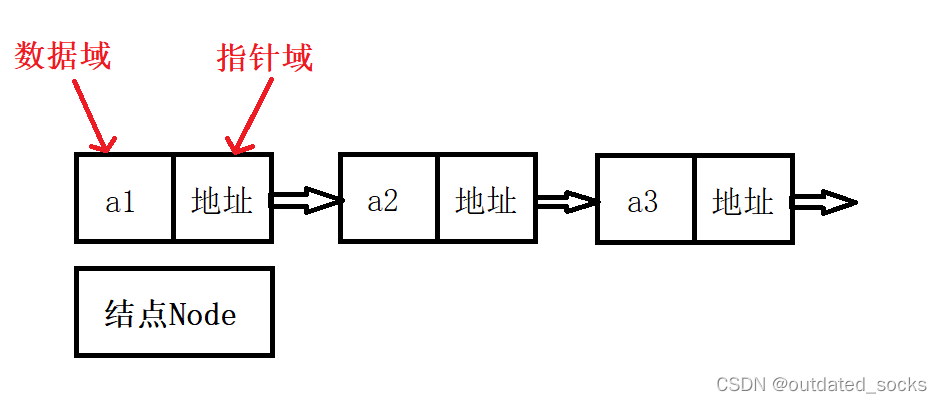
在SList.h下
#pragma once//使同一个文件不会被包含(include)多次,不必担心宏名冲突//先将可能使用到的头文件写上
#include<stdio.h>
#include<stdlib.h>
#include<assert.h>typedef int SLTDataType;//假设结点的数据域类型为 int//单链表的结构体定义
typedef struct SListNode
{SLTDataType data;//结点的数据域,用来存储数据元素struct SListNode* next;//结点的指针域,用来存储下一个结点地址的指针域//next的意思就是下一个结点的指针,上一个结点存的是下一个结点的地址//每个结点都是结构体指针类型//有些人会把上一行代码写成SListNode* next;这是不对的,因为C语言中 //struct SListNode 整体才是一个类型(但C++可以)//或者写成SLTNode* next;这也是错的,因为编译器的查找规则是从上忘下找
}SLTNode;单链表的打印
要理解单链表,首先我们先写一个单链表的打印。
在SList.h下
//链表的打印——助于理解链表
void SLTPrint(SLTNode* phead);#include "SList.h"//别忘了//链表的打印
void SLTPrint(SLTNode* phead)
{//assert(phead);这里并不需要断言phead不为空//为什么这里不需要断言phead?//空链表可以打印,即phead==NULL可以打印,直接断言就不合适了//那空顺序表也可以打印,那它为什么就要断言呢?//因为phead是指向第一个存有数据的结点的//而顺序表的ps是指向一个结构体SLTNode* cur = phead;//将phead赋值给cur,所以cur也指向第一个结点while (cur != NULL)//或while(cur){printf("%d->", cur->data);//打印的时候加了个箭头更方便理解cur = cur->next;//next是下一个结点的地址//++cur/cur++;这种是不行的,指针加加,加到的是连续的下一个位置//链表的每一个结点都是单独malloc出来的,我们不能保证结点之间的地址是连续的}printf("NULL\\n");
}关于为什么不断言phead
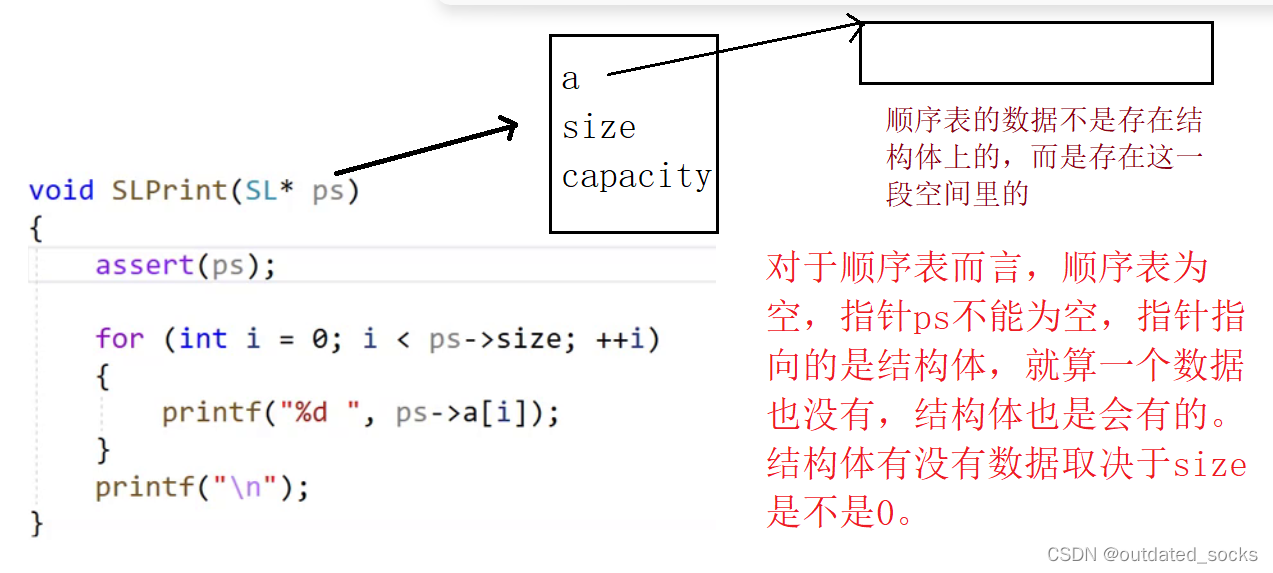
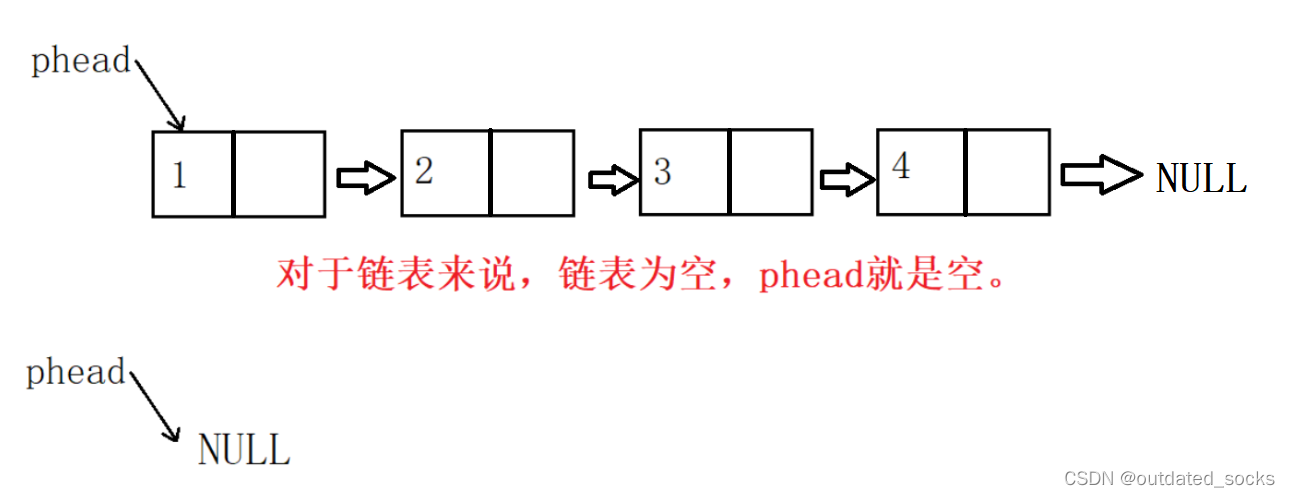
关于单链表的逻辑结构和物理结构



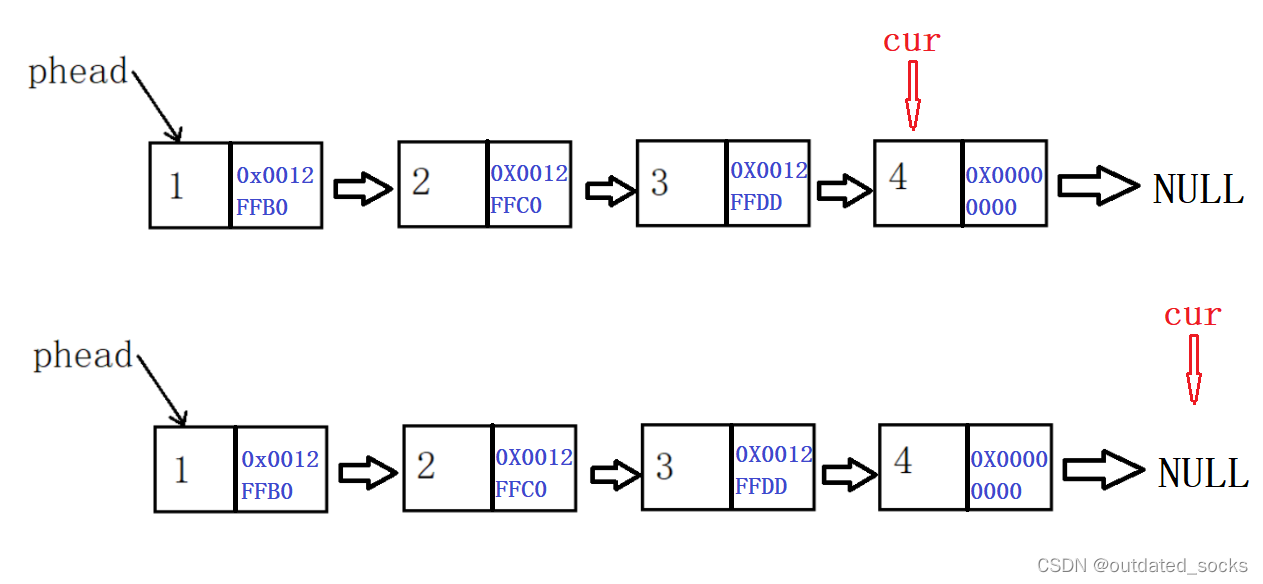
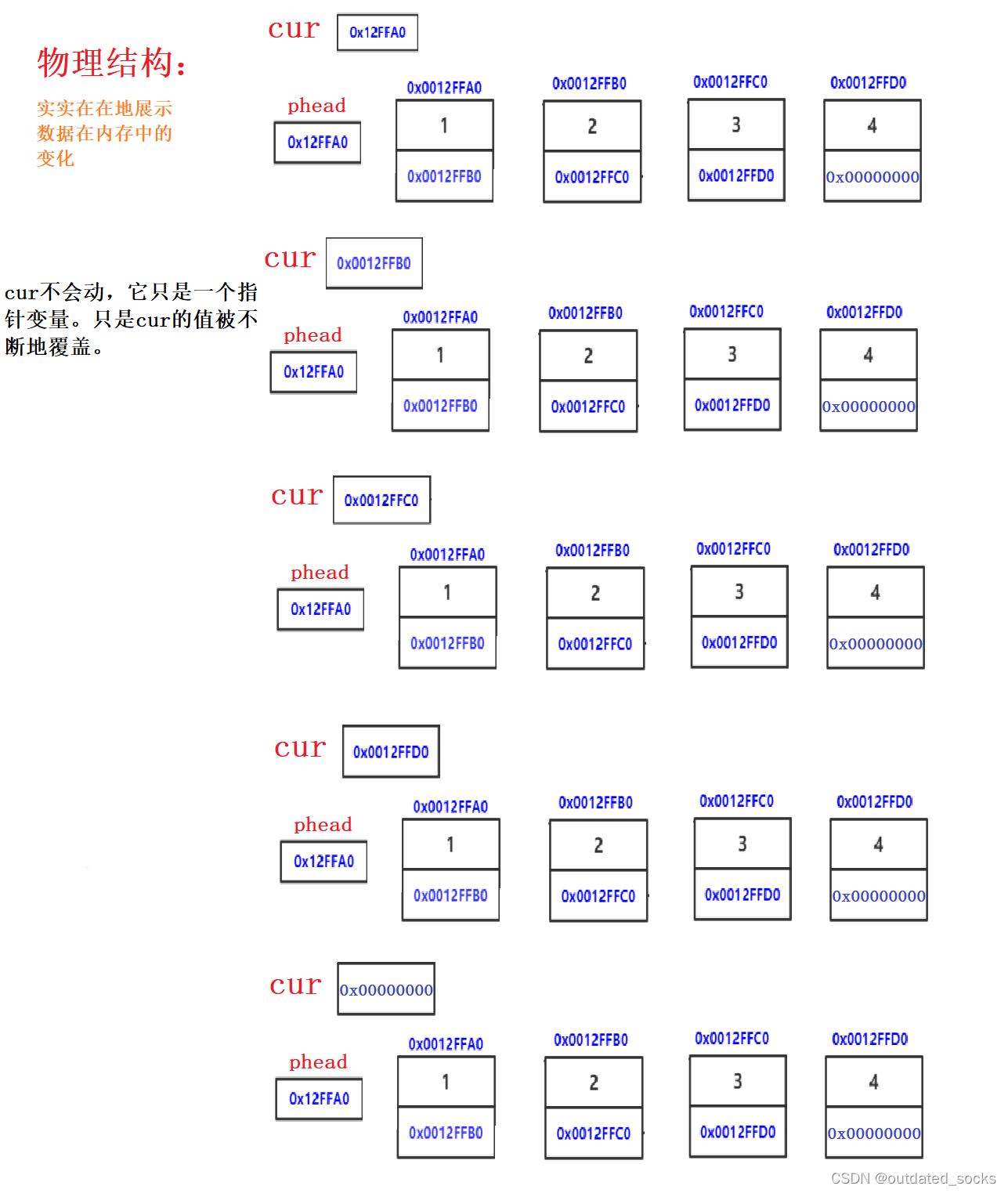
在打印之前,我们得先有数据
单链表的尾插
在SList.h下
// 单链表尾插
void SLTPushBack(SLTNode pphead, SLTDataType x);
//用二级指针,解释看下文,x为要插入的数据关于为什么要用到二级指针
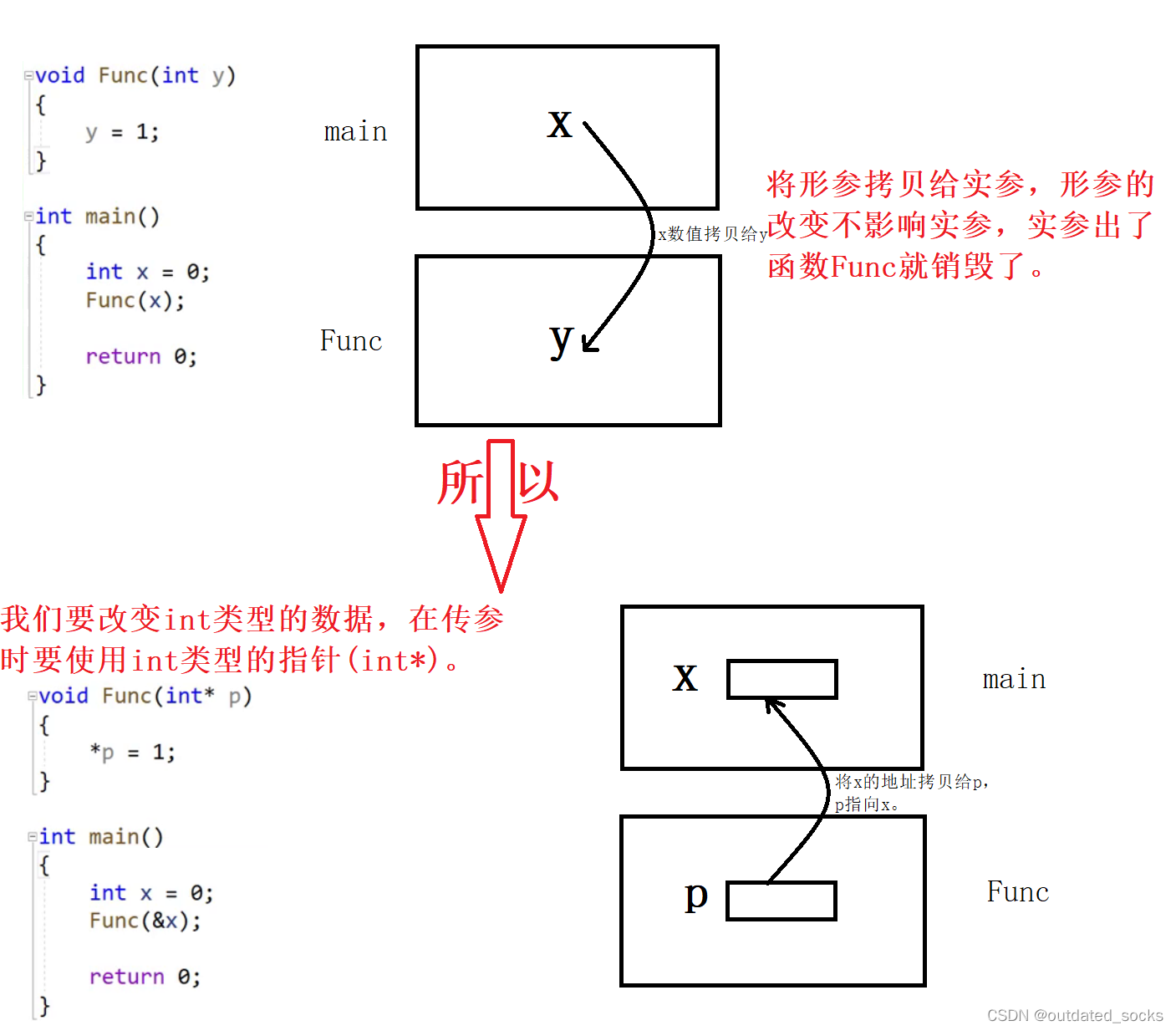
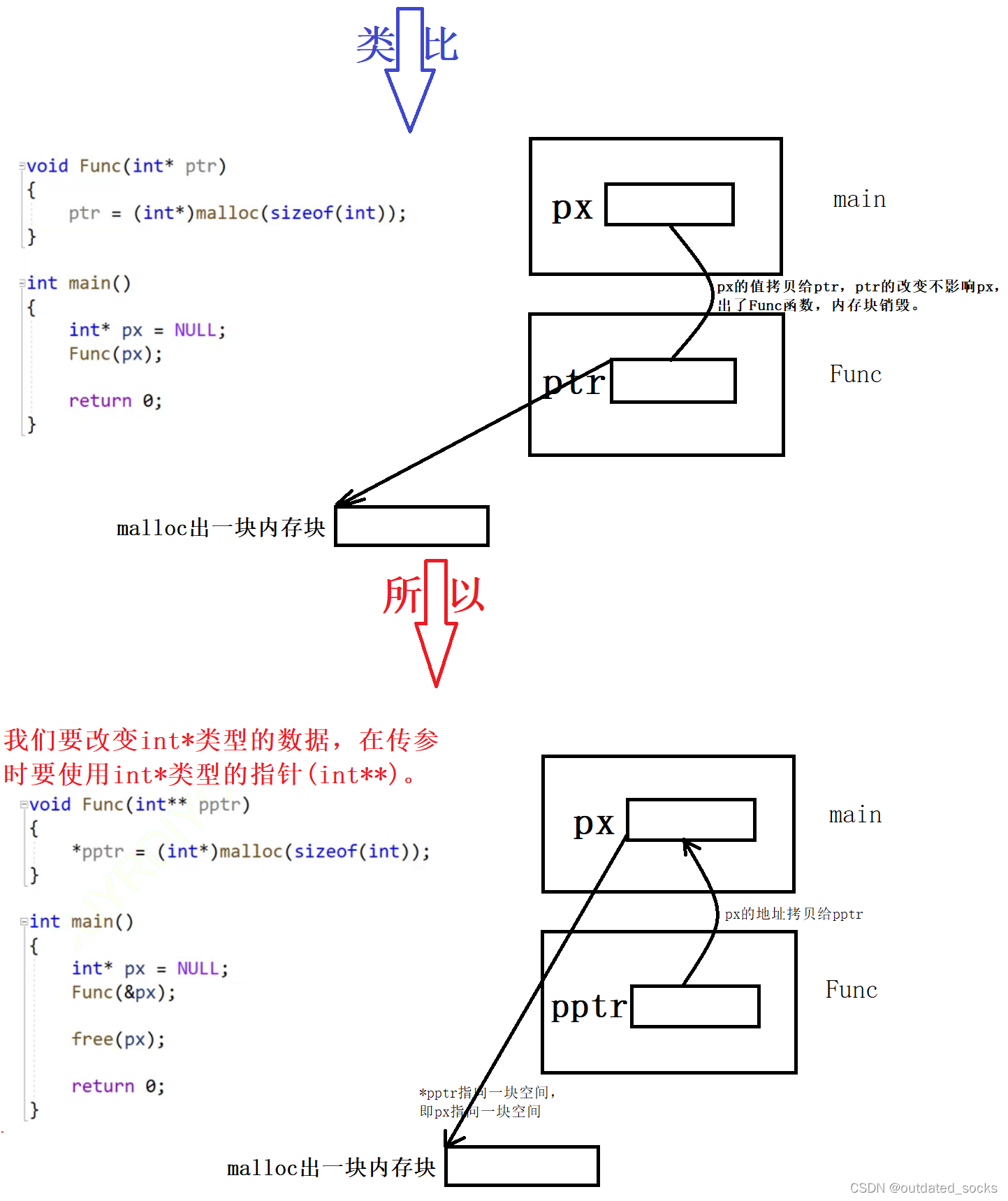
在SList.c下
// 单链表尾插
void SLTPushBack(SLTNode pphead, SLTDataType x)
{assert(pphead);//pphead是plist的地址,不能为空//注意区分几个断言的判断,plist有可能是空,pphead一定不能为空SLTNode* newnode = (SLTNode*)malloc(sizeof(SLTNode));//先创建个结点if (newnode == NULL)//如果malloc失败{perror("malloc fail");return;}//如果malloc成功newnode->data = x;//插入的数据newnode->next = NULL;//初始化为空//找尾(尾插之前先找到尾)if (*pphead == NULL)//若链表为空{*pphead = newnode;}else//若链表不为空{SLTNode* tail = *pphead;while (tail->next != NULL)//对于不为空的链表:尾插的本质//是原尾结点要存新尾结点的地址{tail = tail->next;}tail->next = newnode;/*有些同学会写成:while (tail != NULL){tail = tail->next;}tail = newnode;*/}
}关于尾插的本质

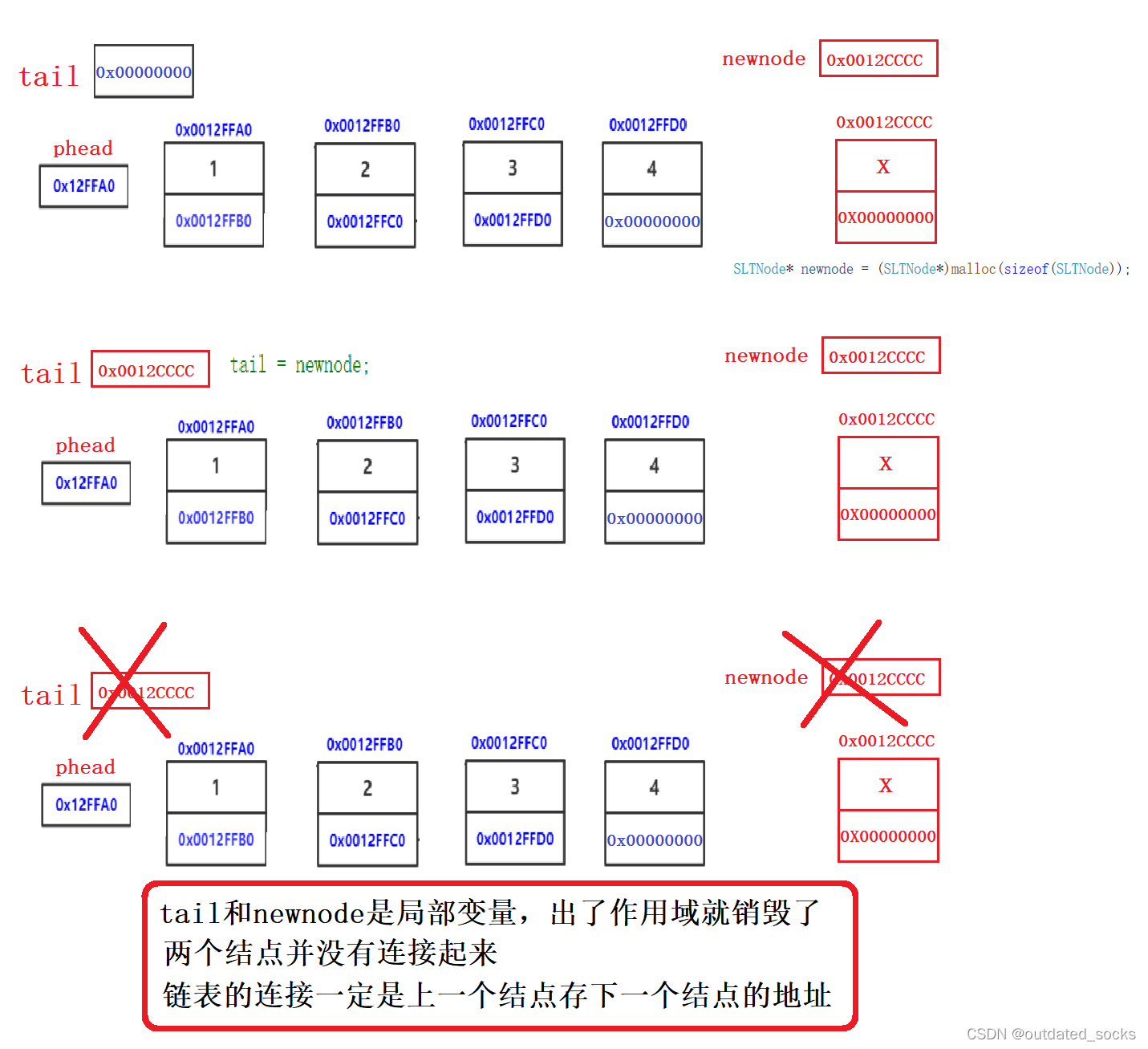
而

关于找尾整个过程的解释
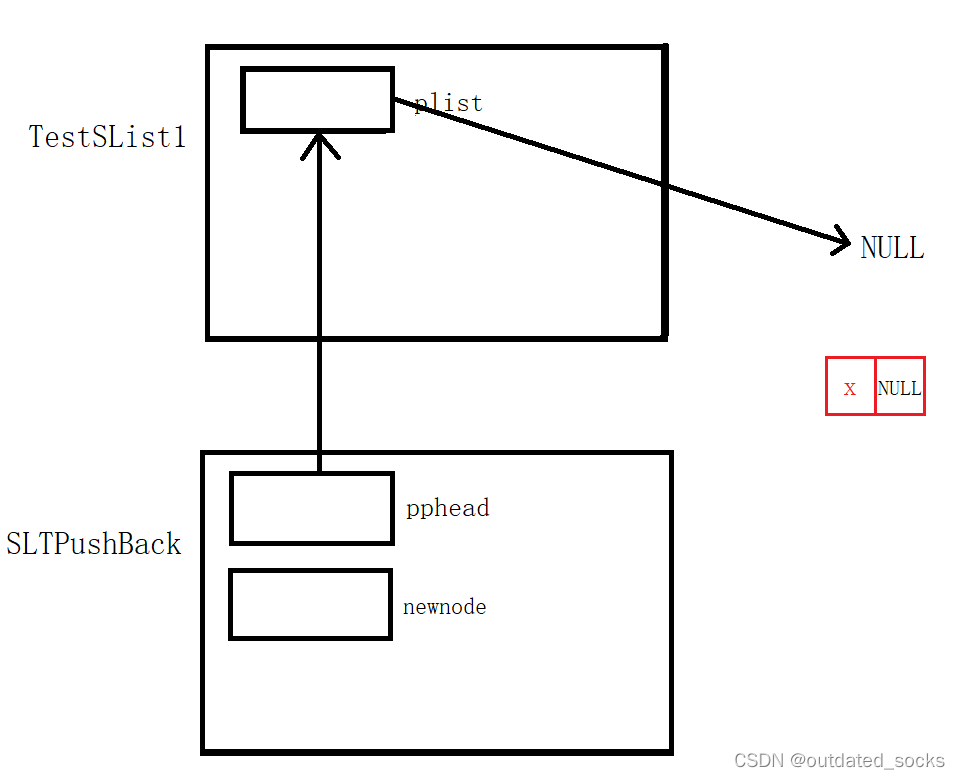
↓

↓
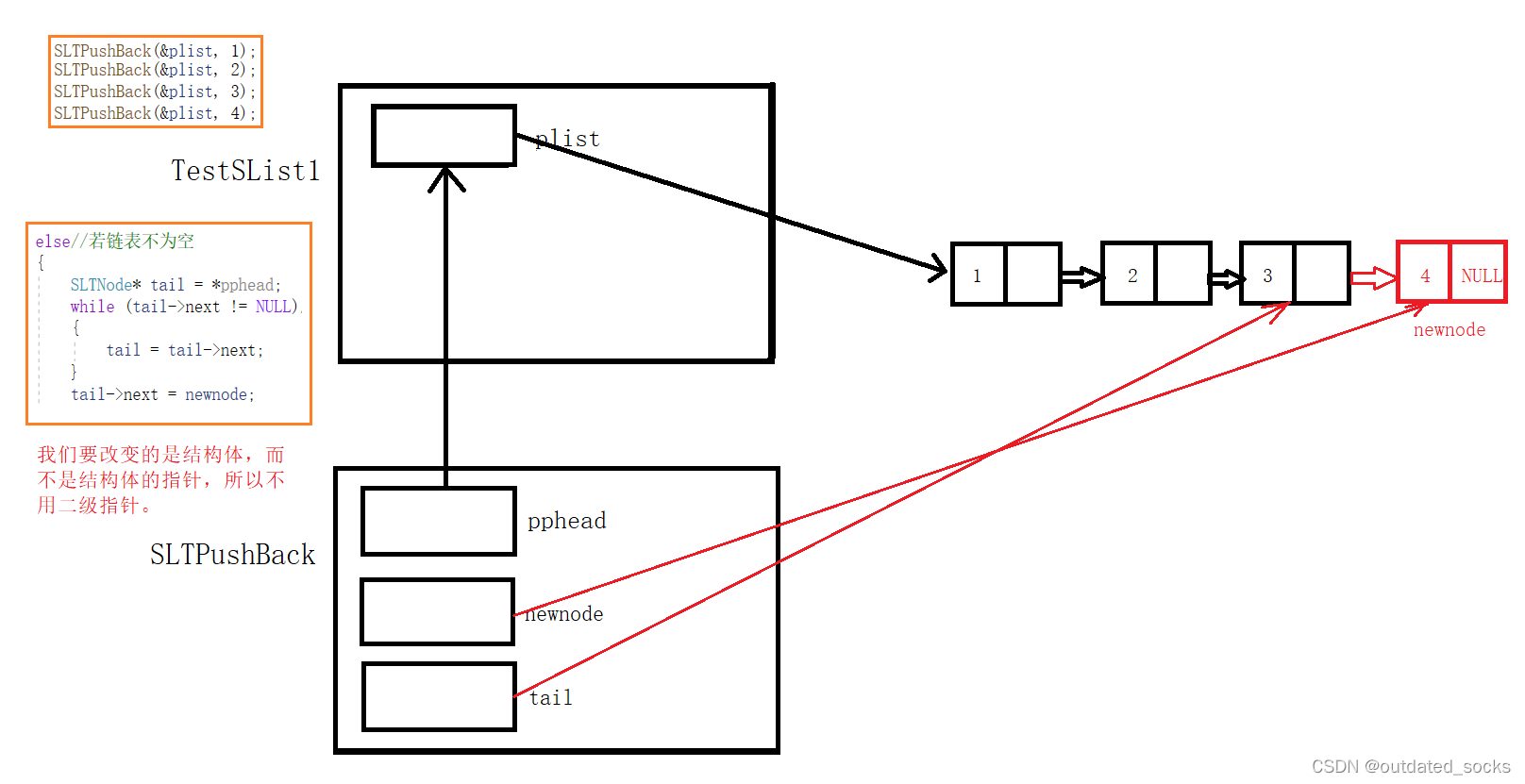
在Test.c下
#include "SList.h"//别忘了//用于函数功能的测试
void TestSList1()
{SLTNode* plist = NULL;SLTPushBack(&plist, 1);SLTPushBack(&plist, 2);SLTPushBack(&plist, 3);SLTPushBack(&plist, 4);SLTPrint(plist);
}int main()
{TestSList1();return 0;
}关于为什么打印单链表就不需要传二级指针
因为打印单链表没有改变指针。如果要改变传过去的指针(实参),那就要传实参的地址,不改变就不传。
单链表的动态申请结点
要写头插时,我们发现不管是尾插和头插都要动态申请一个结点,所以我们可以先写一个函数来复用。
在SList.c下
// 动态申请一个结点
SLTNode* BuySLTNode(SLTDataType x)
{//同样不需要断言SLTNode* newnode = (SLTNode*)malloc(sizeof(SLTNode));//先创建个结点if (newnode == NULL)//如果malloc失败{perror("malloc fail");return NULL;}//如果malloc成功newnode->data = x;//插入的数据newnode->next = NULL;//初始化为空return newnode;//返回newnode
}// 单链表尾插
void SLTPushBack(SLTNode pphead, SLTDataType x)
{assert(pphead);//pphead是plist的地址,不能为空SLTNode* newnode = BuySLTNode(x);//找尾(尾插之前先找到尾)if (*pphead == NULL)//若链表为空{*pphead = newnode;}else//若链表不为空{SLTNode* tail = *pphead;while (tail->next != NULL)//对于不为空的链表:尾插的本质是原尾结点要存新尾结点的地址{tail = tail->next;}tail->next = newnode;/*有些同学会写成:while (tail != NULL){tail = tail->next;}tail = newnode;*/}
}单链表的头插
在SList.h下
// 单链表的头插
void SLTPushFront(SLTNode pphead, SLTDataType x);在SList.c下
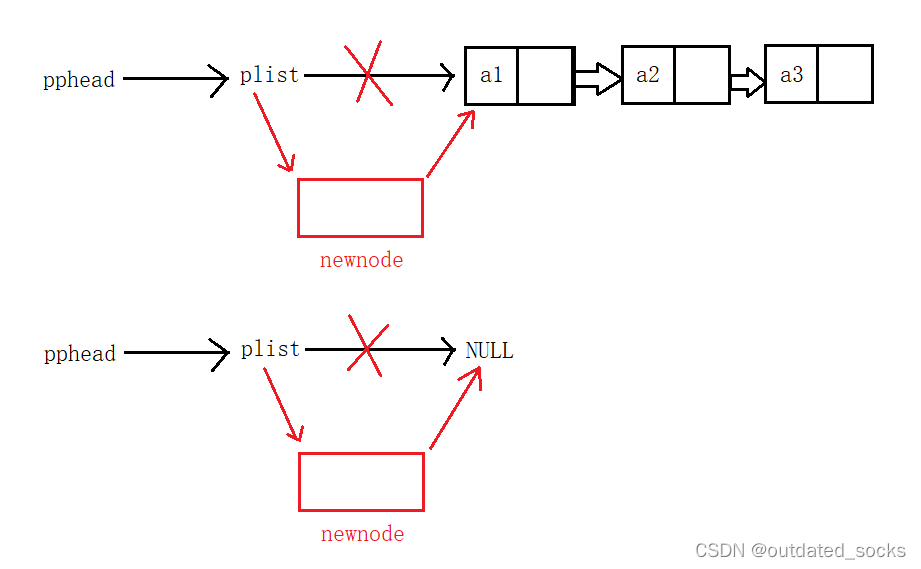
// 单链表的头插
void SLTPushFront(SLTNode pphead, SLTDataType x)
{//发现plist不管是否为空,头插的方法都一样SLTNode* newnode = BuySLTNode(x);newnode->next = *pphead;*pphead = newnode;
}在Test.c下
void TestSList1()
{SLTNode* plist = NULL;SLTPushBack(&plist, 1);SLTPushBack(&plist, 2);SLTPushBack(&plist, 3);SLTPushBack(&plist, 4);SLTPrint(plist);
}void TestSList2()
{SLTNode* plist = NULL;SLTPushFront(&plist, 1);SLTPushFront(&plist, 2);SLTPushFront(&plist, 3);SLTPushFront(&plist, 4);SLTPrint(plist);
}int main()
{TestSList1();TestSList2();return 0;
}
单链表的尾删
尾删是否需要二级指针?要!
在SList.h下
// 单链表的尾删
void SLTPopBack(SLTNode pphead);在Test.c下
void TestSList2()
{SLTNode* plist = NULL;SLTPushFront(&plist, 1);SLTPushFront(&plist, 2);SLTPushFront(&plist, 3);SLTPushFront(&plist, 4);SLTPrint(plist);SLTPopBack(&plist);SLTPrint(plist);
}int main()
{TestSList2();return 0;
}在SList.c下
有些人一开始会这样写:
// 单链表的尾删
void SLTPopBack(SLTNode pphead)
{assert(pphead);//pphead是plist的地址,不能为空SLTNode* tail = *pphead;while (tail->next != NULL){tail = tail->next;}free(tail);tail = NULL;
}结果是:

出现随机值——>很有可能是因为野指针。
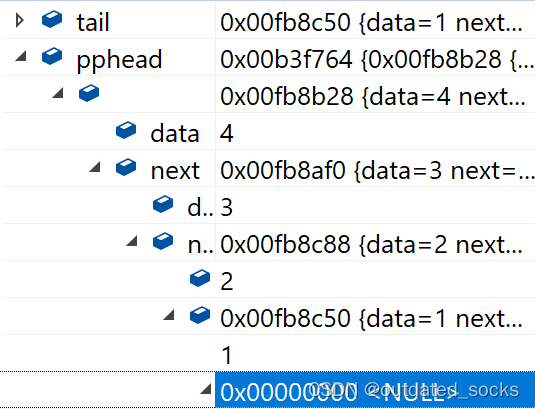 →
→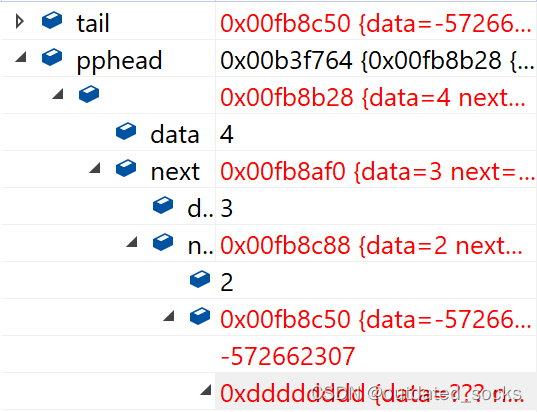
为什么呢?
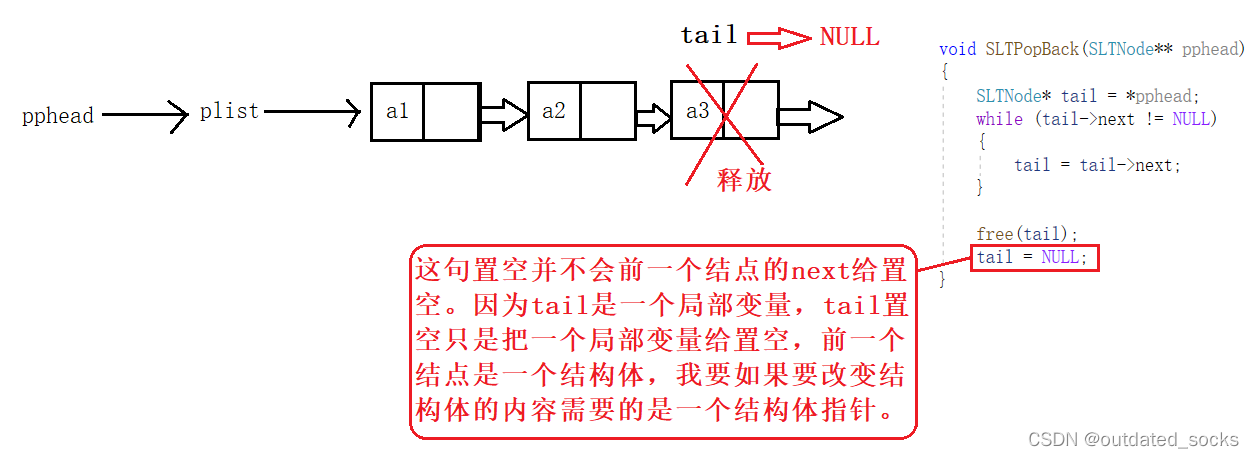
这里给更改后的SList.c的两种方法
法一:
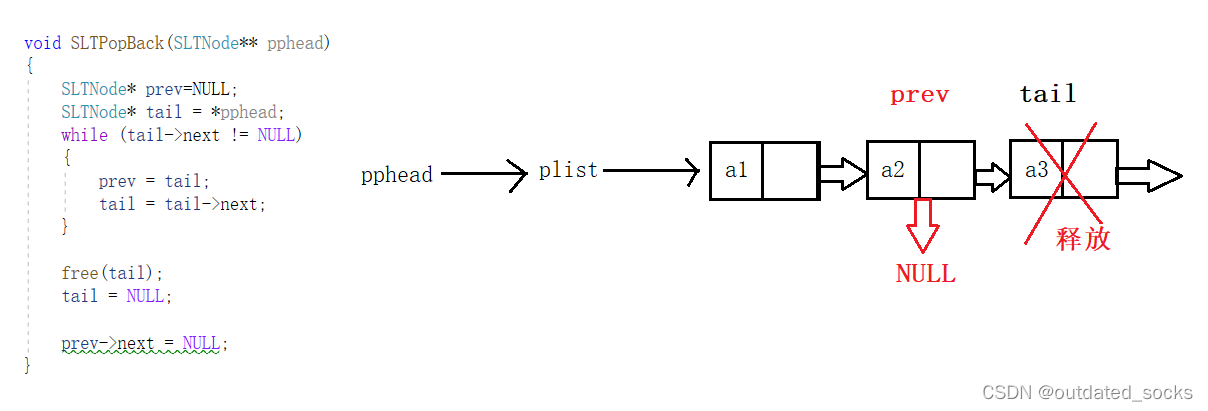
// 单链表的尾删
void SLTPopBack(SLTNode pphead)
{assert(pphead);//pphead是plist的地址,不能为空//法一:SLTNode* prev=NULL;SLTNode* tail = *pphead;while (tail->next != NULL){ prev = tail;tail = tail->next;}free(tail);tail = NULL;prev->next = NULL;
}法二:

// 单链表的尾删
void SLTPopBack(SLTNode pphead)
{assert(pphead);//pphead是plist的地址,不能为空//法二:SLTNode* tail = *pphead;while (tail->next->next != NULL){tail = tail->next;}free(tail->next);tail->next = NULL;
}
但是我们再多测试几组
在Test.c下
void TestSList2()
{SLTNode* plist = NULL;SLTPushFront(&plist, 1);SLTPushFront(&plist, 2);SLTPushFront(&plist, 3);SLTPushFront(&plist, 4);SLTPrint(plist);//尾删四个数据SLTPopBack(&plist);SLTPrint(plist);SLTPopBack(&plist);SLTPrint(plist);SLTPopBack(&plist);SLTPrint(plist);SLTPopBack(&plist);SLTPrint(plist);
}int main()
{TestSList2();return 0;
}结果:
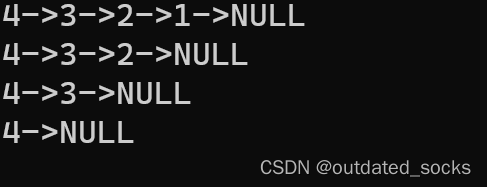 两方法最后都还剩一个!
两方法最后都还剩一个!
原因是未考虑到只有一个结点或没有结点的情况。
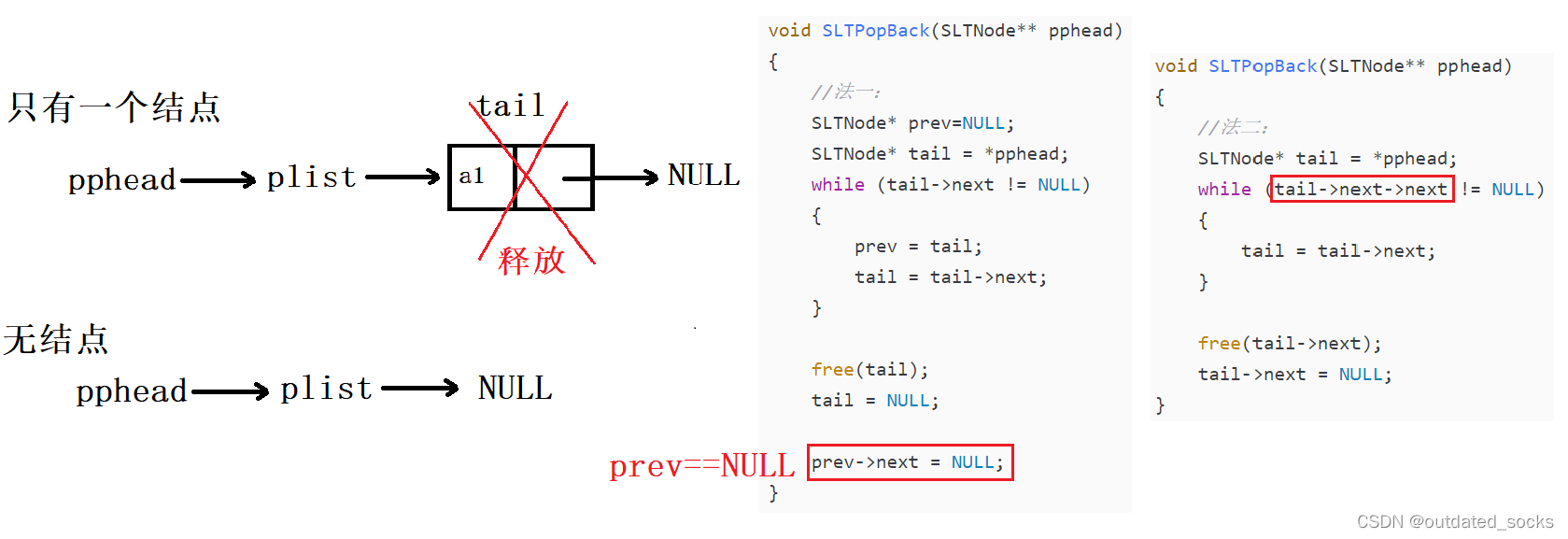
这里是再次更改后的SList.c
// 单链表的尾删
void SLTPopBack(SLTNode pphead)
{assert(pphead);//pphead是plist的地址,不能为空//检查有无结点assert(*pphead != NULL);//1.只有一个结点if ((*pphead)->next == NULL){free(*pphead);*pphead = NULL;}else{//2.有多个结点/*//法一:SLTNode* prev=NULL;SLTNode* tail = *pphead;while (tail->next != NULL){prev = tail;tail = tail->next;}free(tail);tail = NULL;prev->next = NULL;*///法二:SLTNode* tail = *pphead;while (tail->next->next != NULL){tail = tail->next;}free(tail->next);tail->next = NULL;}
}
只有一个结点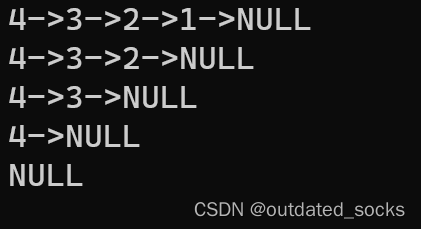
没有结点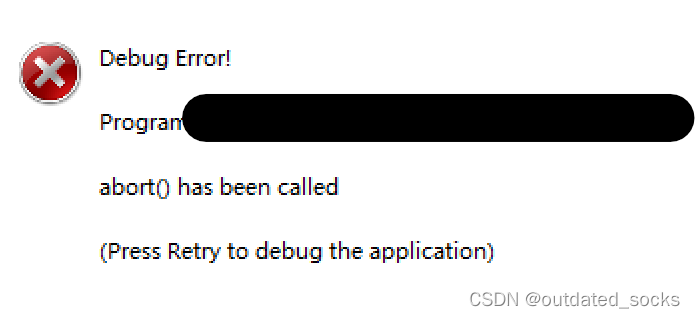
单链表的头删
在SList.h下
// 单链表头删
void SLTPopFront(SLTNode pphead);在SList.c下
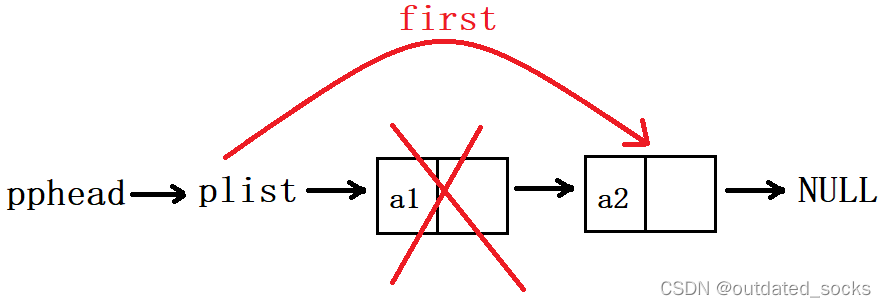
// 单链表头删
void SLTPopFront(SLTNode pphead)
{//检查有无结点assert(*pphead != NULL);SLTNode* first = *pphead;*pphead = first->next;free(first);first = NULL;
}在Test.c下
TestSList3()
{SLTNode* plist = NULL;SLTPushFront(&plist, 1);SLTPushFront(&plist, 2);SLTPushFront(&plist, 3);SLTPushFront(&plist, 4);SLTPrint(plist);SLTPopFront(&plist);SLTPrint(plist);SLTPopFront(&plist);SLTPrint(plist);SLTPopFront(&plist);SLTPrint(plist);SLTPopFront(&plist);SLTPrint(plist);
}int main()
{TestSList3();return 0;
}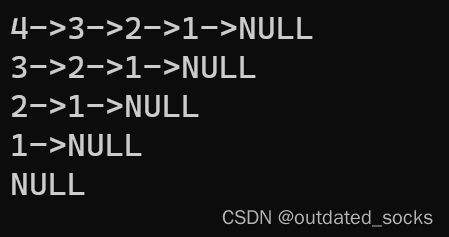
链表的查找
在SList.h下
// 单链表查找
SLTNode* SLTFind(SLTNode* phead, SLTDataType x);在SList.c下
// 单链表查找
SLTNode* SLTFind(SLTNode* phead, SLTDataType x)
{SLTNode* cur = phead;//用cur去遍历,不用pheadwhile (cur)//找x{if (cur->data == x)//如果找到了{return cur;}cur = cur->next;}return NULL;//如果找不到
}在Test.c下
void TestSList4()
{SLTNode* plist = NULL;SLTPushBack(&plist, 1);SLTPushBack(&plist, 2);SLTPushBack(&plist, 3);SLTPushBack(&plist, 4);SLTPrint(plist);//将寻找和修改结合//eg:值为2的结点*2SLTNode* ret = SLTFind(plist, 2);ret->data *= 2;SLTPrint(plist);
}int main()
{TestSList4();return 0;
}
单链表在pos位置之前插入x(也可以理解为在pos位置插入)
在SList.h下
//单链表在pos位置之前插入x(效率较低)(得传头指针)(也可以理解为在pos位置插入)
void SLTInsertBefore(SLTNode pphead, SLTNode* pos, SLTDataType x);在SList.c下

//单链表在pos位置之前插入x(也可以理解为在pos位置插入)
void SLTInsertBefore(SLTNode pphead, SLTNode* pos, SLTDataType x)
{assert(pphead);//pphead是plist的地址,不能为空assert(pos);//默认pos一定会找到if (pos == *pphead)//如果pos在第一个位置——那就是头插{SLTPushFront(pphead, x);}else//如果pos不是第一个位置{//找到pos的前一个位置SLTNode* prev = *pphead;while (prev->next != pos){prev = prev->next;}SLTNode* newnode = BuySLTNode(x);prev->next = newnode;newnode->next = pos;}
}在Test.c下
TestSList5()
{SLTNode* plist = NULL;SLTPushBack(&plist, 1);SLTPushBack(&plist, 2);SLTPushBack(&plist, 3);SLTPushBack(&plist, 4);SLTPrint(plist);//寻找值为2的结点SLTNode* ret = SLTFind(plist, 2);SLTInsertBefore(&plist, ret, 20);//在该结点前插入值为20的结点SLTPrint(plist);}int main()
{TestSList5();return 0;
}
单链表删除pos位置之前的值(也可以理解为删除pos位置的值)
在SList.h下
// 单链表删除pos位置之前的值(效率较低)(得传头指针)(也可以理解为删除pos位置的值)
void SLTEraseBefore(SLTNode pphead, SLTNode* pos);在SList.c下
// 单链表删除pos位置之前的值(也可以理解为删除pos位置的值)
void SLTEraseBefore(SLTNode pphead, SLTNode* pos)
{assert(pphead);assert(pos);if (*pphead == pos)//如果pos在第一个位置{SLTPopFront(pphead);//头删}else//如果不在第一个位置{SLTNode* prev = *pphead;while (prev->next != pos){prev = prev->next;}prev->next = pos->next;free(pos);//pos = NULL;形参的改变不影响实参,加不加这句话都可以}
}在Test.c下
TestSList6()
{SLTNode* plist = NULL;SLTPushBack(&plist, 1);SLTPushBack(&plist, 2);SLTPushBack(&plist, 3);SLTPushBack(&plist, 4);SLTPrint(plist);//寻找值为2的结点SLTNode* ret = SLTFind(plist, 2);SLTEraseBefore(&plist, ret);ret = NULL;//一般在这里置空SLTPrint(plist);
}int main()
{TestSList6();return 0;
}
单链表在pos位置之后插入x
在SList.h下
// 单链表在pos位置之后插入x,单链表比较适合这种
void SLTInsertAfter(SLTNode* pos, SLTDataType x);在SList.c下
有些人会这样写:
//单链表在pos位置之后插入x
void SLTInsertAfter(SLTNode* pos, SLTDataType x)
{assert(pos);SLTNode* newnode = BuySLTNode(x);pos->next = newnode;newnode->next=pos->next;
}后果:
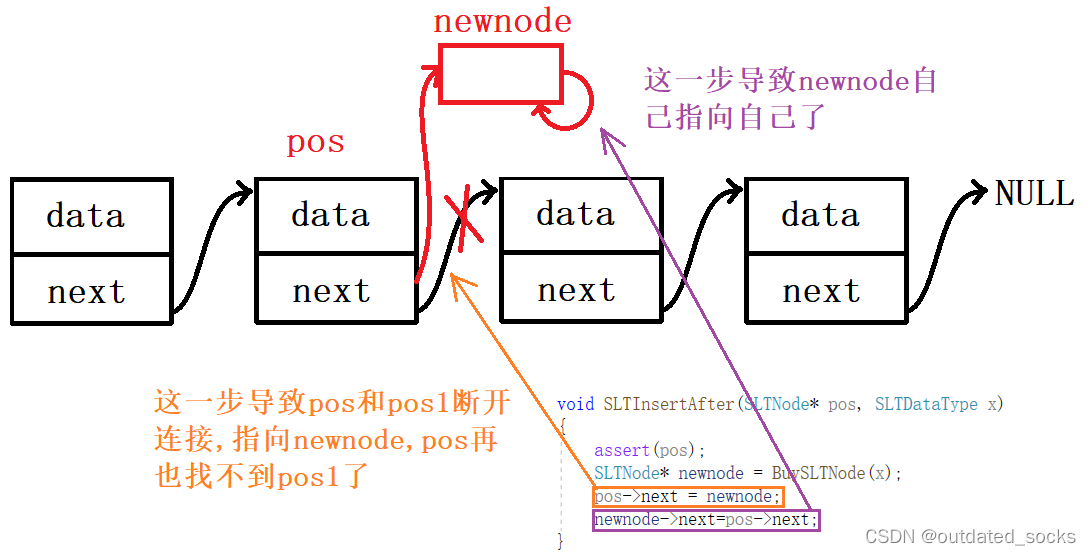
所以橙色和紫色的两步应该互换位置
更改后的SList.c
//单链表在pos位置之后插入x
void SLTInsertAfter(SLTNode* pos, SLTDataType x)
{assert(pos);SLTNode* newnode = BuySLTNode(x);newnode->next = pos->next;pos->next = newnode;
}在Test.c下
TestSList7()
{SLTNode* plist = NULL;SLTPushBack(&plist, 1);SLTPushBack(&plist, 2);SLTPushBack(&plist, 3);SLTPushBack(&plist, 4);SLTPrint(plist);SLTNode* ret = SLTFind(plist, 2);SLTInsertAfter(ret, 20);SLTPrint(plist);
}int main()
{TestSList7();return 0;
}
单链表删除pos位置之后的值
在SList.h下
// 单链表删除pos位置之后的值,单链表比较适合这种
void SLTEraseAfter(SLTNode* pos);在SList.c下

// 单链表删除pos位置之后的值
void SLTEraseAfter(SLTNode* pos)
{assert(pos);assert(pos->next);SLTNode* del = pos->next;//保存要删除的结点pos->next = pos->next->next;//或者写成pos->next=del->next;free(del);del = NULL;
}在Test.c下
TestSList8()
{SLTNode* plist = NULL;SLTPushBack(&plist, 1);SLTPushBack(&plist, 2);SLTPushBack(&plist, 3);SLTPushBack(&plist, 4);SLTPrint(plist);SLTNode* ret = SLTFind(plist, 2);SLTEraseAfter(ret);SLTPrint(plist);
}int main()
{TestSList8();return 0;
}关于不传头指针如何在pos前插入/删除(巧思)
插入:先利用单链表在pos位置之后插入x的函数,再交换pos和pos->next的值。
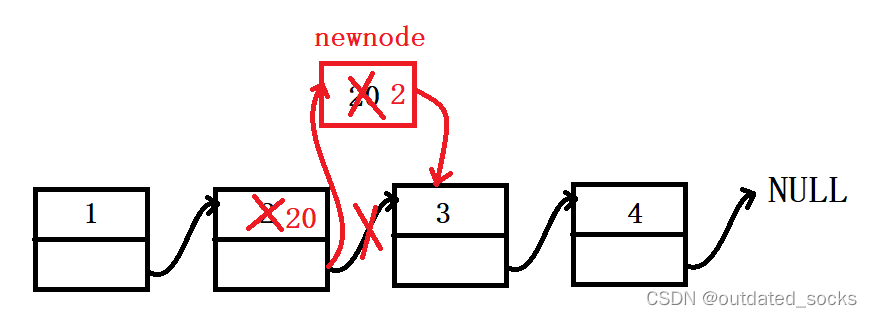
在SList.h下
// 不传头指针,在pos前插入x(也可以理解为在pos位置插入)
void SLTInsertBefore1(SLTNode* pos, SLTDataType x);在SList.c下
// 不传头指针,在pos前插入x(也可以理解为在pos位置插入)
void SLTInsertBefore1(SLTNode* pos, SLTDataType x)
{assert(pos);//调用单链表在pos位置之后插入x的函数SLTInsertAfter(pos, x);//交换pos和pos->next的值SLTDataType temp;temp = pos->data;pos->data = pos->next->data;pos->next->data = temp;
}在Test.c下
TestSList9()
{SLTNode* plist = NULL;SLTPushBack(&plist, 1);SLTPushBack(&plist, 2);SLTPushBack(&plist, 3);SLTPushBack(&plist, 4);SLTPrint(plist);SLTNode* ret = SLTFind(plist, 2);SLTInsertBefore1(ret,20);SLTPrint(plist);
}int main()
{TestSList9();return 0;
}删除:先将pos->next的值赋给pos,再利用单链表删除pos位置之后的值的函数。(但此方法不能尾删)
 在SList.h下
在SList.h下
// 不传头指针,删除pos位置之前的值(也可以理解为删除pos位置的值)
void SLTEraseBefore1(SLTNode* pos);在SList.c下
// 不传头指针,删除pos位置之前的值(也可以理解为删除pos位置的值)
void SLTEraseBefore1(SLTNode* pos)
{assert(pos);assert(pos->next);//不能尾删SLTNode* del = pos->next;pos->data = pos->next->data;pos->next = pos->next->next;free(del);del = NULL;
}在Test.c下
TestSList10()
{SLTNode* plist = NULL;SLTPushBack(&plist, 1);SLTPushBack(&plist, 2);SLTPushBack(&plist, 3);SLTPushBack(&plist, 4);SLTPrint(plist);SLTNode* ret = SLTFind(plist, 2);SLTEraseBefore1(ret);SLTPrint(plist);
}int main()
{TestSList10();return 0;
}
总代码(想直接看结果的可以看这里)
在SList.h下
#pragma once//使同一个文件不会被包含(include)多次,不必担心宏名冲突//先将可能使用到的头文件写上
#include<stdio.h>
#include<stdlib.h>
#include<assert.h>typedef int SLTDataType;//假设结点的数据域类型为 int// 单链表的结构体定义
// ↓结点 单链表 Singly Linked List
typedef struct SListNode
{SLTDataType data;//结点的数据域,用来存储数据元素struct SListNode* next;//结点的指针域,用来存储下一个结点地址的指针域//next的意思就是下一个结点的指针,上一个结点存的是下一个结点的地址//每个结点都是结构体指针类型//有些人会把上一行代码写成SListNode* next;//这是不对的,因为C语言中 struct SListNode 整体才是一个类型(但C++可以)//或者写成SLTNode* next;这也是不对的,因为编译器的查找规则是从上忘下找
}SLTNode;// 链表的打印——助于理解链表
void SLTPrint(SLTNode* phead);// 单链表尾插
void SLTPushBack(SLTNode pphead, SLTDataType x);//用二级指针,x为要插入的数据// 单链表的头插
void SLTPushFront(SLTNode pphead, SLTDataType x);// 单链表的尾删
void SLTPopBack(SLTNode pphead);// 单链表头删
void SLTPopFront(SLTNode pphead);// 单链表查找
SLTNode* SLTFind(SLTNode* phead, SLTDataType x);// 单链表在pos位置之前插入x(效率较低)(得传头指针)(也可以理解为在pos位置插入)
void SLTInsertBefore(SLTNode pphead, SLTNode* pos, SLTDataType x);// 单链表删除pos位置之前的值(效率较低)(得传头指针)(也可以理解为删除pos位置的值)
void SLTEraseBefore(SLTNode pphead, SLTNode* pos);// 单链表在pos位置之后插入x,单链表比较适合这种
void SLTInsertAfter(SLTNode* pos, SLTDataType x);// 单链表删除pos位置之后的值,单链表比较适合这种
void SLTEraseAfter(SLTNode* pos);// 不传头指针,在pos前插入x(也可以理解为在pos位置插入)
void SLTInsertBefore1(SLTNode* pos, SLTDataType x);// 不传头指针,删除pos位置之前的值(也可以理解为删除pos位置的值)
void SLTEraseBefore1(SLTNode* pos);在SList.c下
#include"SList.h"//别忘了//链表的打印
void SLTPrint(SLTNode* phead)
{//assert(phead);这里并不需要断言phead不为空//为什么这里不需要断言?//空链表可以打印,即phead==NULL可以打印,直接断言就不合适了//那空顺序表也可以打印,那它为什么就要断言呢?//因为phead是指向第一个存有数据的结点的//而顺序表的ps是指向一个结构体SLTNode* cur = phead;//将phead赋值给cur,所以cur也指向第一个结点while (cur != NULL)//或while(cur){printf("%d->", cur->data);//打印的时候加了个箭头更方便理解cur = cur->next;//next是下一个结点的地址//++cur/cur++;这种是不行的,指针加加,加到的是连续的下一个位置//链表的每一个结点都是单独malloc出来的,我们不能保证结点之间的地址是连续的}printf("NULL\\n");
}// 动态申请一个结点
SLTNode* BuySLTNode(SLTDataType x)
{//同样不需要断言SLTNode* newnode = (SLTNode*)malloc(sizeof(SLTNode));//先创建个结点if (newnode == NULL)//如果malloc失败{perror("malloc fail");return NULL;}//如果malloc成功newnode->data = x;//插入的数据newnode->next = NULL;//初始化为空return newnode;//返回newnode
}// 单链表尾插
void SLTPushBack(SLTNode pphead, SLTDataType x)
{assert(pphead);//pphead是plist的地址,不能为空//注意区分几个断言的判断,plist有可能是空,pphead一定不能为空SLTNode* newnode = BuySLTNode(x);//找尾(尾插之前先找到尾)if (*pphead == NULL)//若链表为空{*pphead = newnode;}else//若链表不为空{SLTNode* tail = *pphead;while (tail->next != NULL)//对于不为空的链表:尾插的本质是原尾结点存新尾结点的地址{tail = tail->next;}tail->next = newnode;/*有些同学会写成:while (tail != NULL){tail = tail->next;}tail = newnode;*/}
}// 单链表的头插
void SLTPushFront(SLTNode pphead, SLTDataType x)
{assert(pphead);//pphead是plist的地址,不能为空//发现plist不管是否为空,头插的方法都一样SLTNode* newnode = BuySLTNode(x);newnode->next = *pphead;*pphead = newnode;
}// 单链表的尾删
void SLTPopBack(SLTNode pphead)
{assert(pphead);//pphead是plist的地址,不能为空//检查有无结点assert(*pphead != NULL);//或者写成assert(*pphead);//1.只有一个结点if ((*pphead)->next == NULL){free(*pphead);*pphead = NULL;}else{//2.有多个结点/*//法一:SLTNode* prev=NULL;SLTNode* tail = *pphead;while (tail->next != NULL){prev = tail;tail = tail->next;}free(tail);tail = NULL;prev->next = NULL;*///法二:SLTNode* tail = *pphead;while (tail->next->next != NULL){tail = tail->next;}free(tail->next);tail->next = NULL;}
}// 单链表头删
void SLTPopFront(SLTNode pphead)
{assert(pphead);//pphead是plist的地址,不能为空//检查有无结点assert(*pphead != NULL);SLTNode* first = *pphead;*pphead = first->next;free(first);first = NULL;
}// 单链表查找
SLTNode* SLTFind(SLTNode* phead, SLTDataType x)
{SLTNode* cur = phead;//用cur去遍历,不用pheadwhile (cur)//找x{if (cur->data == x)//如果找到了{return cur;}cur = cur->next;}return NULL;//如果找不到
}//单链表在pos位置之前插入x(也可以理解为在pos位置插入)
void SLTInsertBefore(SLTNode pphead, SLTNode* pos, SLTDataType x)
{assert(pos);//默认pos一定会找到assert(pphead);//pphead是plist的地址,不能为空if (pos == *pphead)//如果pos在第一个位置——那就是头插{SLTPushFront(pphead, x);}else//如果pos不是第一个位置{//找到pos的前一个位置SLTNode* prev = *pphead;while (prev->next != pos){prev = prev->next;}SLTNode* newnode = BuySLTNode(x);prev->next = newnode;newnode->next = pos;}
}// 单链表删除pos位置之前的值(也可以理解为删除pos位置的值)
void SLTEraseBefore(SLTNode pphead, SLTNode* pos)
{assert(pphead);assert(pos);if (*pphead == pos)//如果pos在第一个位置{SLTPopFront(pphead);//头删}else//如果不在第一个位置{SLTNode* prev = *pphead;while (prev->next != pos){prev = prev->next;}prev->next = pos->next;free(pos);//pos = NULL;形参的改变不影响实参,加不加这句话都可以}
}//单链表在pos位置之后插入x
void SLTInsertAfter(SLTNode* pos, SLTDataType x)
{assert(pos);SLTNode* newnode = BuySLTNode(x);newnode->next = pos->next;pos->next = newnode;
}// 单链表删除pos位置之后的值
void SLTEraseAfter(SLTNode* pos)
{assert(pos);assert(pos->next);SLTNode* del = pos->next;//保存要删除的结点pos->next = pos->next->next;//或者写成pos->next=del->next;free(del);del = NULL;
}// 不传头指针,在pos前插入x(也可以理解为在pos位置插入)
void SLTInsertBefore1(SLTNode* pos, SLTDataType x)
{assert(pos);//调用单链表在pos位置之后插入x的函数SLTInsertAfter(pos, x);//交换pos和pos->next的值SLTDataType temp;temp = pos->data;pos->data = pos->next->data;pos->next->data = temp;
}// 不传头指针,删除pos位置之前的值(也可以理解为删除pos位置的值)
void SLTEraseBefore1(SLTNode* pos)
{assert(pos);assert(pos->next);//不能尾删SLTNode* del = pos->next;pos->data = pos->next->data;pos->next = pos->next->next;free(del);del = NULL;
}在Test.c下
#include"SList.h"//别忘了void TestSList1()
{SLTNode* plist = NULL;SLTPushBack(&plist, 1);SLTPushBack(&plist, 2);SLTPushBack(&plist, 3);SLTPushBack(&plist, 4);SLTPrint(plist);
}void TestSList2()
{SLTNode* plist = NULL;SLTPushFront(&plist, 1);SLTPushFront(&plist, 2);SLTPushFront(&plist, 3);SLTPushFront(&plist, 4);SLTPrint(plist);SLTPopBack(&plist);SLTPrint(plist);SLTPopBack(&plist);SLTPrint(plist);SLTPopBack(&plist);SLTPrint(plist);SLTPopBack(&plist);SLTPrint(plist);
}TestSList3()
{SLTNode* plist = NULL;SLTPushFront(&plist, 1);SLTPushFront(&plist, 2);SLTPushFront(&plist, 3);SLTPushFront(&plist, 4);SLTPrint(plist);SLTPopFront(&plist);SLTPrint(plist);SLTPopFront(&plist);SLTPrint(plist);SLTPopFront(&plist);SLTPrint(plist);SLTPopFront(&plist);SLTPrint(plist);
}void TestSList4()
{SLTNode* plist = NULL;SLTPushBack(&plist, 1);SLTPushBack(&plist, 2);SLTPushBack(&plist, 3);SLTPushBack(&plist, 4);SLTPrint(plist);//将寻找和修改结合//eg:值为2的结点*2SLTNode* ret = SLTFind(plist, 2);ret->data *= 2;SLTPrint(plist);
}TestSList5()
{SLTNode* plist = NULL;SLTPushBack(&plist, 1);SLTPushBack(&plist, 2);SLTPushBack(&plist, 3);SLTPushBack(&plist, 4);SLTPrint(plist);//寻找值为2的结点SLTNode* ret = SLTFind(plist, 2);SLTInsertBefore(&plist, ret, 20);//在该结点前插入值为20的结点SLTPrint(plist);}TestSList6()
{SLTNode* plist = NULL;SLTPushBack(&plist, 1);SLTPushBack(&plist, 2);SLTPushBack(&plist, 3);SLTPushBack(&plist, 4);SLTPrint(plist);//寻找值为2的结点SLTNode* ret = SLTFind(plist, 2);SLTEraseBefore(&plist, ret);ret = NULL;//一般在这里置空SLTPrint(plist);
}TestSList7()
{SLTNode* plist = NULL;SLTPushBack(&plist, 1);SLTPushBack(&plist, 2);SLTPushBack(&plist, 3);SLTPushBack(&plist, 4);SLTPrint(plist);SLTNode* ret = SLTFind(plist, 2);SLTInsertAfter(ret, 20);SLTPrint(plist);
}TestSList8()
{SLTNode* plist = NULL;SLTPushBack(&plist, 1);SLTPushBack(&plist, 2);SLTPushBack(&plist, 3);SLTPushBack(&plist, 4);SLTPrint(plist);SLTNode* ret = SLTFind(plist, 2);SLTEraseAfter(ret);SLTPrint(plist);
}TestSList9()
{SLTNode* plist = NULL;SLTPushBack(&plist, 1);SLTPushBack(&plist, 2);SLTPushBack(&plist, 3);SLTPushBack(&plist, 4);SLTPrint(plist);SLTNode* ret = SLTFind(plist, 2);SLTInsertBefore1(ret,20);SLTPrint(plist);
}TestSList10()
{SLTNode* plist = NULL;SLTPushBack(&plist, 1);SLTPushBack(&plist, 2);SLTPushBack(&plist, 3);SLTPushBack(&plist, 4);SLTPrint(plist);SLTNode* ret = SLTFind(plist, 2);SLTEraseBefore1(ret);SLTPrint(plist);
}int main()
{//TestSList1();//TestSList2();//TestSList3();//TestSList4();//TestSList5();//TestSList6();//TestSList7();//TestSList8();//TestSList9();TestSList10();return 0;
}欢迎指正❀



